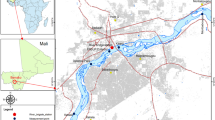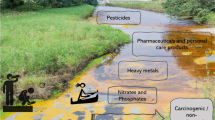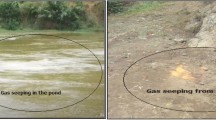Abstract
Rivers, the main source of the domestic water supply in Malaysia, have been threatened by frequent flooding in recent years. This study aims to assess human health risks associated with exposure to concentrated heavy metals in a flood-prone region of Malaysia and investigate the affected individuals’ willingness to participate in managing water resources. Hazard indices and cancer risks associated with water contamination by heavy metals have been assessed following the method prescribed by the US Environmental Protection Agency. Yearly data of heavy metal contamination (Cd, Cr, Pb, Zn, Fe), water quality parameters (DO, BOD, COD, pH), and climatic information (annual rainfall, annual temperature) have been collected from the Department of Environment and Meteorological Department of Malaysia, respectively. The inductively coupled plasma mass spectrometry technique has been used by the department of environment for analyzing heavy metal concentration in river water samples. In this study, data from a stratified random sample of households in the affected region were analyzed, using partial least squares structural equation modeling, to predict the link between individuals’ perceptions and attitudes about water resources and their willingness to engage in water management program. The health risk estimation indicated that the hazard index values were below the acceptable limit, representing no non-carcinogenic risk to adults and children residing in the study area via oral intake and dermal adsorption of water. However, the calculated value for cancer risk signified possible carcinogenic risks associated with Pb and Cd. In general, contamination due to pollution and flooding tends to increase in the basin region, and appropriate management is needed. The results identified perceived water quality as a significant factor influencing people's attitudes toward involvement in water management programs. As in many developing countries, there is no legal provision guaranteeing public representation in water management in Malaysia. The conclusion discusses the importance of these for the literature and for informing future policy actions.



Similar content being viewed by others
References
Ab Razak, N. H., Praveena, S. M., Aris, A. Z., & Hashim, Z. (2015). Drinking water studies: A review on heavy metal, application of biomarker and health risk assessment (a special focus in Malaysia). Journal of Epidemiology and Global Health, 5(4), 297–310.
Adilah, A. N., and Nadia, H. N. (2020). Water quality status and heavy metal contains in selected rivers at Tasik Chini due to increasing land use activities. In IOP Conference Series: Materials Science and Engineering (Vol. 712, No. 1, p. 012022). IOP Publishing.
Abidin, R. Z. R. Z., & Unit, E. P. (2004). Water resources management in Malaysia: The way forward. Buletin Ingenieur, 22, 8–10.
Ahmed, M. F., Alam, L., Ta, G. C., & Mokhtar, M. (2017). A review on lead (Pb) contamination in the drinking water supply at Langat River Basin. Malaysia. MOJ Toxicology, 3(2), 47–49.
Ahmed, M. F., Mokhtar, M. B., Alam, L., Mohamed, C. A. R., & Ta, G. C. (2019). Non-carcinogenic health risk assessment of aluminium ingestion via drinking water in Malaysia. Exposure and Health, 11(2), 167–180.
Ajzen, I. (1985). From intentions to actions: A theory of planned behavior. In J. Kuhl & J. Beckmann (Eds.), Action control: From cognition to behavior (pp. 11–39). Berlin, Heidelberg: Springer.
Alam, L., & Mohamed, C. A. R. (2011). Natural radionuclide of Po 210 in the edible seafood affected by coal-fired power plant industry in Kapar coastal area of Malaysia. Environmental Health, 10(1), 43.
Alam, L., Alam, M. M., Mokhtar, M. B., Bar, M. A., Kathijotes, N., Ta, G. C., & Ern, L. K. (2015). Seasonal variation and preliminary risk assessment of trace element pollution in surface water from Langat River, Malaysia. International Journal of Applied Environmental Sciences, 10(1), 19–40.
Azman, A.N.Z (2017). Potential impact of bauxite mining activity on water quality at sungai Pengorak, Kuantan catchment area. Bachelor thesis. Universiti Malaysia Pahang.
Bernama. (2017). Flood situation in Pahang and Johor improving, Perak unchanged. Astro Awani Network Sdn. Bhd.\ http://english.astroawani.com/malaysia-news/flood-situation-pahang-and-johor-improving-perak-unchanged-131067. Accessed 15 Feb 2017.
Bjerregaard, R. (1998). Getting Europe’s waters cleaner: Getting the citizens involved. Water Policy, 1(1), 73–80.
Burstein, P. (2010). Public opinion, public policy, and democracy Handbook of politics (pp. 63–79). Berlin: Springer.
Carr, G., Blöschl, G., & Loucks, D. (2012). Evaluating participation in water resource management: A review. Water Resources Research, 48(11), 1–17.
Fishbein, M., & Ajzen, I. (1975). Belief, attitude, intention, and behavior: An introduction to theory and research. Reading, MA: Addison-Wesley.
Floodlist. (2013). Floods in Pahang and Sarwak, Malaysia The Malay Online; Borneo Post. Retrieved February 15 2017 from http://floodlist.com/asia/pahang-sarwak-malaysia.
Gasim, M. B., Ismail, B. S., Toriman, E., Mir, S. I., & Chek, T. C. (2007). A physico-chemical assessment of the Bebar River, Pahang Malaysia. Global Journal of Environmental Research, 1(1), 7–11.
Hani, A., & Pazira, E. (2011). Heavy metals assessment and identification of their sources in agricultural soils of Southern Tehran Iran. Journal of Environmental Monitoring and Assessment, 176(2), 677–691.
Hair, Jr., J. F., Hult, G. T. M., Ringle, C., & Sarstedt, M. (2016). A primer on partial least squares structural equation modeling (PLS-SEM). Sage Publications.
Halkos, G., & Matsiori, S. (2014). Exploring social attitude and willingness to pay for water resources conservation. Journal of Behavioral and Experimental Economics, 49, 54–62.
Haque, M. A. S., & Jewel1, J. Hasan, M. M. Islam, S. Ahmed, L. Alam, Ganges, P. A. S. . (2019). Seasonal variation and ecological risk assessment of heavy metal contamination in surface waters of the Ganges River (Northwestern Bangladesh). Malaysian Journal of Analytical Sciences, 23(2), 300–311.
Henseler, J., Hubona, G., & Ray, P. A. (2016). Using PLS path modeling in new technology research: Updated guidelines. Industrial Management and Data Systems, 116(1), 2–20.
Howitt, J. A., Baldwin, D. S., Rees, G. N., & Williams, J. L. (2007). Modelling blackwater: Predicting water quality during flooding of lowland river forests. Ecological Modelling, 203(3–4), 229–242.
Jennewein, J. S., & Jones, K. W. (2016). Examining ‘willingness to participate’ in community-based water resource management in a transboundary conservation area in Central America. Water Policy, 18(6), 1334–1352.
Ker Rault, P. A., Vreugdenhil, H., Jeffrey, P., & Slinger, J. H. (2013). Readiness and willingness of the public to participate in integrated water management: Some insights from the Levant. Water Policy, 15(S2 Suppl. 2), 101–120.
Kozaki, D., Harun, N., Rahim, M., Mori, M., Nakatani, N., & Tanaka, K. (2017). Determination of water quality degradation due to industrial and household wastewater in the Galing River in Kuantan, Malaysia using ion chromatograph and water quality data. Environments, 4(2), 35.
Lee, I., Hwang, H., Lee, J., Yu, N., Yun, J., & Kim, H. (2017). Modeling approach to evaluation of environmental impacts on river water quality: A case study with Galing River. Kuantan, Pahang, Malaysia. https://doi.org/10.1016/j.ecolmodel.2017.01.021.
Li D, Liu S (2019) Chapter 8 - Water quality detection for Lakes. In: Li D, Liu S (Ed) Water Quality Monitoring and Management. (pp 221–231) Elsevier.
Lohani, M. B., Singh, A., Rupainwar, D. C., & Dhar, D. N. (2008). Seasonal variations of heavy metal contamination in River Gomti of Lucknow City Region. Journal of Environmental Monitoring and Assessment., 147(1), 253–263.
Lono, A., Kumar, G. S., & Chye, T. T. (2010). Prevalence of Microsporidia in an indigenous Orang Asli community in Pahang, Malaysia. Transactions of the Royal Society of Tropical Medicine and Hygiene, 104(3), 214–218.
Manap, N., Sandirasegaran, K., Syahrom, N. S., & Amir, A. (2019). Analysis of trace metal contamination in Pahang River and Kelantan River, Malaysia. In MATEC Web of Conferences (Vol. 266, p. 04003). EDP Sciences.
Mohammadi, A. A., Zarei, A., Majidi, S., Ghaderpoury, A., Hashempour, Y., Saghi, M. H., & Ghaderpoori, M. (2019). Carcinogenic and non-carcinogenic health risk assessment of heavy metals in drinking water of Khorramabad. Iran. MethodsX, 6, 1642–1651.
Mokhtar, M., & Hj. Torima, M. E., & Abraham Ho, A. (2010). Social learning in facing challenges of sustainable development: A case of Langat River Basin. Malaysia. Research Journal of Applied Sciences, 5(6), 434–443.
Mokhtar, M. B., Toriman, M. E. H., Hossain, M. A. A., & Tan, K. W. (2011). Institutional challenges for integrated river basin management in Langat River Basin. Malaysia. Water and Environment Journal, 25(4), 495–503.
Mustapha, A., & Nabegu, A. B. (2011). Surface water pollution source identification using principal component analysis and factor analysis in Getsi River, Kano, Nigeria. Australian Journal of Basic and Applied Sciences, 5, 1507–1512.
Nadiri, A. A., Shokri, S., Tsai, F. T. C., & Moghaddam, A. A. (2018). Prediction of effluent quality parameters of a wastewater treatment plant using a supervised committee fuzzy logic model. Journal of Cleaner Production, 180, 539–549.
Organization for Economic Co-Operation and Development (OECD). (2012). Water quality and agriculture: Meeting the policy challenge. OECD Studies on water: OECD Publishing.
Rashidi, H., GhaffarianHoseini, A., GhaffarianHoseini, A., Nik Sulaiman, N. M. N., Tookey, J., & Hashim, N. A. (2015). Application of wastewater treatment in sustainable design of green built environments: A review. Renewable and Sustainable Energy Reviews, 49, 845–856.
Rodriguez-Proteau, R., & Grant, R. L. (2005). Toxicity evaluation and human health risk assessment of surface and ground water contaminated by recycled hazardous waste materials. Water Pollution (pp. 133–189). Berlin: Springer.
Rotich, E. C., Omboto, P. I., & Nassiuma, B. (2018). The determinants of willingness to pay for improved management of water projects among households in Baringo County Kenya. International Journal of Innovative Research and Development, 7(1), 220–233.
Siriwardana, C., Cooray, A. T., Liyanage, S. S., & Koliyabandara, S. M. P. A. (2019). Seasonal and spatial variation of dissolved oxygen and nutrients in Padaviya reservoir, Sri Lanka. Journal of Chemistry, 2019, 1–11.
Sobahan, M. A., Mir, S. I., Zakaria, I., & Hossain, M. (2013). Surface Water Contamination Due To Industrial Activities in Gebeng Area, Kuantan, Malaysia. In International Conference on Civil and Architecture Engineering, 6–7.
Stoutenborough, J. W., & Vedlitz, A. (2014). The effect of perceived and assessed knowledge of climate change on public policy concerns: An empirical comparison. Environmental Science and Policy, 37, 23–33.
Tachikawa, Y., James, R., Abdullah, K., Desa, M. N. M. (2004). Catalogue of rivers for Southeast Asia and the Pacific, V. http://flood.dpri.kyoto-u.ac.jp/ihp_rsc/riverCatalogue/Vol_05/. Accessed January 10 2019.
Tan, K. W., & Mokhtar, M. (2009). An appropriate institutional framework towards integrated water resources management in Pahang River basin Malaysia. European journal of scientific research, 27(4), 536–547.
Tariq, Q. (2015). First wave of Kuantan flood victims evacuated. The Star Online. http://www.thestar.com.my/news/nation/2015/12/28/first-wave-of-kuantan-flood-victims-evacuated/. Accessed February 15 2017.
Tekolla, A. W. (2010) [Masters Thesis]. https://lup.lub.lu.se/luur/download?func=downloadFile&recordOId=1701272&fileOId=1701282. Sweden: Lunds Universitet. Accessed November 14 2017.
USEPA, (2004.) Risk assessment guidance for superfund Volume I: human health evaluation manual (Part E, Supplemental guidance for dermal risk assessment) In book risk assessment guidance for superfund volume I: Human Health Evaluation Manual (Part E, Supplemental Guidance for Dermal Risk Assessment) U.S. Environmental Protection Agency.
USEPA. (2006). Risk-based concentration table. Washington DC, Philadelphia: United States Environmental Protection Agency.
Wang, Z., Zou, R., Zhu, X., He, B., Yuan, G., Zhao, L., & Liu, Y. (2014). Predicting lake water quality responses to load reduction: A three-dimensional modeling approach for total maximum daily load. International Journal of Environmental Science and Technology, 11(2), 423–436.
Živković, N., Takić, L., Djordjević, L., Djordjević, A., Mladenović-Ranisavljević, I., Golubović, T., & Božilov, A. (2019). Concentrations of heavy metal cations and a health risk assessment of sediments and river surface water: A case study from a Serbian mine. Polish Journal of Environmental Studies, 28(3), 2009–2020.
Acknowledgements
We would like to thank all the people and organizations that contribute to this research and towards the completion of this article. This research has been conducted under the Pan-Asia Risk Reduction Fellowship Program offered by START and funded by the research projects provided by START and the Ministry of Higher Education of Malaysia through the research project code TRGS/1/2015/UKM/02/5/2. The authors are grateful to Ibnu Rusydy for his great help in producing study area map.
Author information
Authors and Affiliations
Corresponding author
Additional information
Publisher's Note
Springer Nature remains neutral with regard to jurisdictional claims in published maps and institutional affiliations.
Rights and permissions
About this article
Cite this article
Alam, L., Rahman, L.F., Ahmed, M.F. et al. Assessment of health risks and individuals’ willingness to participate in drinking water management at flood-prone Pahang River Basin, Malaysia. Environ Geochem Health 43, 2049–2063 (2021). https://doi.org/10.1007/s10653-020-00783-0
Received:
Accepted:
Published:
Issue Date:
DOI: https://doi.org/10.1007/s10653-020-00783-0




